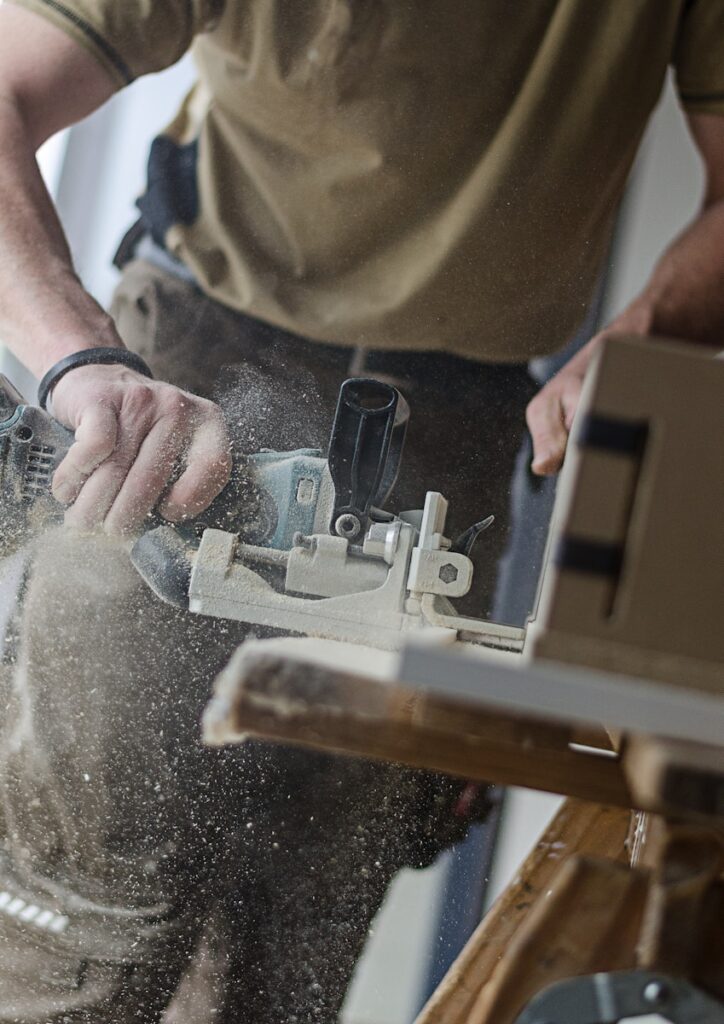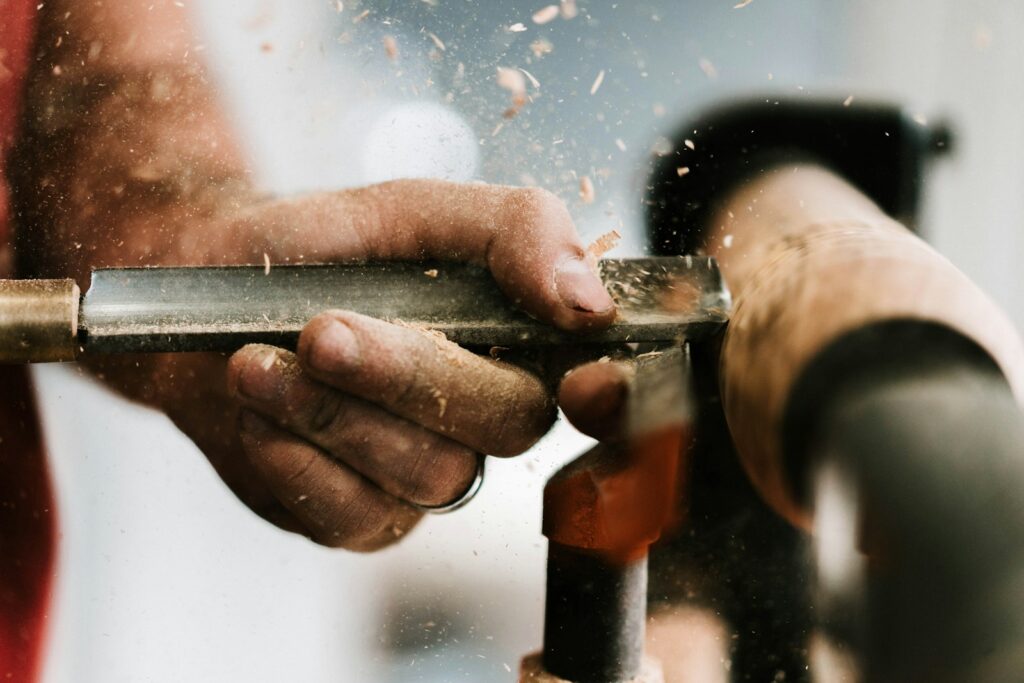What is a carpenter? Carpentry is an age-old profession that has been around for centuries. Carpenters are skilled craftsmen who specialize in designing, building and repairing structures made mostly of wood.
From homes, furniture, cabinets, to ships and bridges, carpentry involves a lot of hard work and attention to detail. Carpenters also work on other structures, including a wide variety of architectural, infrastructural, and interior elements, showcasing the broad scope of their craft. In this blog, we explore what a carpenter is, the skills and tools they use, and the different types of carpentry.
What is a Carpenter?
A carpenter is an artisan who specializes in woodwork. They work with wood, making and repairing structures that are used in construction like buildings and bridges, or items like furniture, cabinets, and other wood-based products.
Many carpenters also work on installation and repair projects, such as installing kitchen cabinets, flooring, or repairing damage to walls.
Skills and Tools
Carpenters are skilled craftsmen who require a combination of physical strength, problem-solving, creativity and technical know-how. To be an excellent carpenter, you need a broad range of skills, including good math skills, physical dexterity, and attention to detail.
Additionally, carpenters use a variety of hand and power tools such as hammers, saws, planes, chisels, drills and many others, to shape wood, assemble materials, and make precise cuts.

Photo by Austin Ramsey on Unsplash
Work Environment
Carpenters work in a wide range of environments, from bustling construction sites to quiet workshops and busy factories. Depending on the construction project, carpenters may find themselves working indoors on detailed cabinetry or outdoors on large-scale building frames. The nature of carpenters work often requires them to adapt to changing weather conditions, especially when working on exterior projects or in unfinished buildings.
On construction sites, carpenters frequently collaborate with other construction workers, such as electricians, plumbers, and masons, to ensure that each phase of the project runs smoothly. The job can involve working at heights, navigating cramped spaces, or operating in areas with limited lighting, all of which require careful attention to safety.
The use of power tools is a daily part of the job, with equipment like circular saws, drills, and sanders generating significant noise and dust. To protect themselves, carpenters wear safety gear such as earplugs, masks, and protective eyewear. Whether working independently or as part of a larger team, carpenters play a vital role in bringing construction projects to life, adapting to the unique challenges of each job site.
Types of Carpentry
There are many different types of carpentry, and carpenters can specialize in a particular type of work. For example, rough carpenters work with larger structural elements like beams, rafters, and support frames, while finish carpenters concentrate on smaller elements like installing trim, baseboards, and cabinets.
Carpenters work indoors when performing tasks such as pre-fabrication in shops or factories, especially for finish carpenters.
Moreover, cabinet makers create and install custom cabinets and furniture for homes, offices, restaurants, and other businesses, while shipwrights build and repair boats and ships.
Carpentry is a highly skilled profession that involves the cutting, shaping, and joining of various materials to create structural and decorative elements. As a craft, it has been around for centuries, and has evolved into different disciplines.
There are several types of carpentry that exist, each with its set of skills, many power tools or hand tools, and techniques required to complete the task.
Rough Carpentry
Rough carpentry is the type of carpentry that deals with the structural elements of a building, both residential construction and nonresidential building construction. It is usually the first stage of construction, and involves the creation of frames, beams, and columns.
The materials used in rough carpentry are usually heavy and sturdy, such as timber, or steel. The tools used by construction workers in rough carpentry include saws, braces, hammers, and nails.
Rough carpentry is crucial in ensuring that the building is stable and can withstand the weight of the rest of the structure. Carpenters can impact building construction timelines by how fast they work on the job site.
Finish Carpentry
Finish carpentry or trim carpentry is the type of carpentry that deals with the decorative elements of the building. It is the final stage of construction and involves the installation of moldings, skirting boards, baseboards, doors, and cabinets. A finish carpenter is also known as a trim carpenter.
The materials used in finish carpentry are usually lighter and more refined, such as lumber or MDF board. The tools used in finish carpentry are also more precise, such as saws, chisels, framing squares, and sanders. Finish carpentry requires a high level of attention to detail to achieve a smooth and polished appearance.
Cabinetmaking
Cabinetmaking is a specialized type of carpentry that involves the construction of cabinets and furniture. It is a highly skilled trade that requires precision and proficiency in joinery, carving, and finishing.
The materials used in cabinetmaking are usually hardwood, such as oak or cherry, and the tools used are specialized, such as mortise and tenon jigs, and hand planes. Cabinetmaking requires a keen eye for design and aesthetics to produce beautiful and functional pieces. Most carpenters can make and install cabinets and other furniture.
Roof Carpentry
Roof carpentry is the type of carpentry that involves the construction of the roof structure. It requires a thorough understanding of geometry and structural design to create a solid and stable roof system.
The materials used in roof carpentry are usually timber, steel, or aluminum. The tools used in roof carpentry include saws, hammers, and measuring tools. Roof carpentry requires an eye for detail to ensure that the roof design is efficient and meets the building code.
Green Carpentry
Green carpentry is the type of carpentry that promotes sustainable and eco-friendly practices. It involves the use of renewable and recycled materials, such as bamboo or reclaimed lumber. Green carpentry also involves reducing waste and minimizing the impact on the environment during construction.
The tools used in green carpentry are usually the same as those used in other types of carpentry. Green carpentry requires a commitment to environmentally conscious practices and a willingness to explore new techniques and materials.
Ship Carpentry
Ship carpentry is a unique type of carpentry that deals with the construction and repair of boats and ships.
This type of carpentry requires a deep understanding of boat building techniques, such as lofting, planking, and framing, as well as knowledge about different types of wood that can withstand the rigors of the sea.
Restoration Carpentry
Restoration carpentry involves repairing and renovating old and historic buildings. This type of carpentry is different from other types of carpentry as it requires a knowledge of traditional techniques and materials used in different eras.
Restoration carpenters are responsible for maintaining the authenticity of the building while ensuring that it is safe and structurally sound. They also can fix broken furniture and repair structures of vintage pieces.

Photo by Janosch Lino on Unsplash
Exploring the Importance of the Carpentry Trade
Carpentry is one of the oldest trades in human history, dating back to ancient times. It is the art of constructing and repairing wooden structures and has been an integral part of human civilization.
Employment population growth increases the demand for new construction, which in turn creates more job opportunities for carpenters.
From the ships we sail on to the homes we live in, the carpentry trade has contributed significantly to the growth of civilization.
The Beauty and Functionality of Wooden Structures
Architects, builders, and designers depend on the carpentry trade to bring their designs to life. Wood is a versatile material that can be molded, shaped, and cut to create stunning buildings, furniture, and other wooden structures. With a skilled carpenter’s expert craftsmanship, wood can be transformed into beautiful and functional structures that last for years.
The Economic Significance of Carpentry
Carpentry is an essential part of the construction projects, which is a significant driver of the economy. According to the Bureau of Labor Statistics, the demand for carpenters is expected to increase by 8% from 2018 to 2028, faster than the average for all occupations.
This job growth is attributed to the need for new residential and commercial construction, as well as an increased demand for renovations and repairs. However, despite limited employment growth in the field, there will still be many job openings as companies need to replace workers who retire or transfer to other occupations. Experienced carpenters don’t work with modular and prefabricated components, they use wood and other materials to build a beautiful masterpiece.
The Environmental Benefits of Wooden Structures
Wood is a renewable resource, and wooden structures have a significantly lower carbon footprint compared to other building materials. Wood requires less energy to produce and process than steel, concrete, or brick. Moreover, wood is biodegradable and recyclable, making it an eco-friendly choice. As the world focuses on sustainable development, carpentry skills will play a crucial role in providing environmentally-friendly building solutions
Preserving Tradition and Heritage
Fully trained carpenters are also important for preserving tradition and heritage. Skilled carpenters can reproduce historic wooden structures with great fidelity, preserving the cultural heritage of communities around the world.
Carpentry can be seen as an art form, with craftsmanship and traditional techniques passed down from generation to generation. As new technology advances, it’s important to remember the value of preserving traditional carpentry techniques and craftsmanship.
The Personal Rewards of Carpentry
Carpentry is a trade that offers many personal rewards. Like any skilled profession, mastering the art of carpentry requires dedication, hard work, and patience. As a carpenter develops their skills, they gain a sense of accomplishment and pride in their work. This trade offers the freedom to create and build, making it a satisfying and fulfilling career.

Photo by Annie Gray on Unsplash
The Education a Carpenter Must Have
Carpentry is one of the oldest trades, and its popularity has not waned over time. It is a skilled profession that requires expertise, knowledge, and the right tools to transform wood into beautiful and functional structures.
The median annual wages for carpenters represent the midpoint of carpenter earnings, meaning half of carpenters earn more and half earn less; this figure can vary based on experience and industry.
While carpentry may involve a specific set of learned skills, the education aspiring carpenters need can vary depending on their experience level and chosen expertise.
High School Education
Like any other trade, carpentry could benefit from high school education. While a degree isn’t required, taking classes in woodshop or drafting could better prepare students for the field. Aspiring carpenters may also take vocational or technical education classes, which teach the basics of carpentry or cabinetry. Most people require a high school diploma before you can receive specialized training to become a carpenter.
Apprenticeship Program
An apprenticeship program is a great option for those looking to learn the trade while working with experienced carpenters. The program can last up to four years. The four year apprenticeship program requirements can be intense and involves on-the-job training with classroom instruction on building trades.
Apprentices gain experience on blueprint reading and reading a mechanical drawing, measure and cut wood, and use various carpentry tools, including saws, chisels, and clamps. Enrolling in an apprenticeship program can help aspiring carpenters gain practical experience and the knowledge that comes with it.
Vocational School or Community College
Vocational schools and community colleges offer carpentry programs that can range from a few months to two years. These programs include classroom instruction, hands-on experience, and technical training. Students learn how to build structures, read blueprints, use tools safely, and understand building codes and regulations.
This is a great way for people to learn carpentry basics. Graduates from vocational schools or community colleges may earn certifications such as NCCER (National Center for Construction Education and Research), which can increase their chances of being hired. This is basically pre-apprenticeship training, as most places require on-the-job experience. Many aspiring carpenters start as a carpenter’s helper, gaining valuable exposure to tools, processes, and trade skills that are essential for career development in carpentry.
Continuing Education
After completing a carpentry program, an aspiring carpenter may want to pursue additional training or education to widen their skill-set or define their area of expertise. This can include taking advanced carpentry courses or obtaining a specialized certification in a specific field, such as framing or cabinetry.
Real-World Experience
The practical skills required for carpentry can only truly be learned on the job. Real-world experience can help develop skills such as problem-solving, construction site rules and regulations, and communication with team members and general construction supervisors. We recommend that aspiring carpenters seek out jobs or internships to help them establish a sound understanding of the craft.
Career Paths in Carpentry
The carpentry trade offers a variety of career paths, allowing individuals to specialize and grow within the construction industry. Many carpenters start by focusing on rough carpentry, where they build the structural framework of buildings, or move into finish carpentry and trim carpentry, which involve more detailed and decorative work.
With experience, carpenters can advance to positions such as general construction supervisors, overseeing teams and managing entire construction projects. Others may choose to become independent contractors, running their own businesses and taking on projects directly for clients.
Some carpenters develop expertise in specialized areas like scaffold building or constructing concrete forms, which can lead to higher pay and increased job security. As the industry evolves, there is also growing demand for skills related to modular and prefabricated components, offering new opportunities for those willing to learn the latest techniques and materials.
For those interested in broader roles, carpenters can transition into related fields such as construction management or building inspection, where their hands-on experience is highly valued. Staying current with industry trends and continuing education is key to long-term success in the carpentry trade.
Physical Demands of Carpentry
Carpenters face a range of physical demands in their daily work. The job often involves lifting heavy building materials, bending, kneeling, and standing for extended periods. These repetitive motions, combined with the frequent use of hand and power tools like hammers, saws, and drills, can lead to strain or injuries if proper precautions are not taken.
Working at heights or in confined spaces adds another layer of physical challenge, requiring balance, strength, and agility. Carpenters must also be prepared to work in various environmental conditions, from hot summer days to cold winter mornings, which can affect their comfort and stamina.
To reduce the risk of injuries and illnesses, carpenters are encouraged to follow safety protocols, use protective gear, and maintain good physical fitness through regular exercise and stretching. Employers play a crucial role by providing training and support to help carpenters manage the physical aspects of the job, ensuring a safer and healthier work environment.
Workplace Safety
Safety is a top priority in the carpentry trade, where workers are exposed to a variety of hazards on the job. Common risks include falls from ladders or scaffolding, cuts from sharp tools, and electrical shocks when working near wiring. To minimize these dangers, carpenters are trained to follow strict safety protocols and use protective equipment such as hard hats, safety glasses, and steel-toed boots.
Employers are responsible for creating a safe workplace by offering proper training, maintaining equipment, and providing adequate supervision. Regular safety inspections and risk assessments help identify potential hazards before they lead to accidents, fostering a culture of safety among all workers.
By prioritizing workplace safety, carpenters can significantly reduce the risk of injuries and illnesses, ensuring they remain healthy and productive throughout their careers. A strong commitment to safety benefits not only individual carpenters but also the entire construction project and team.
Earnings and Benefits
Carpentry offers competitive wages, with the median annual wage for carpenters around $50,000. Experienced carpenters, especially those specializing in high-demand areas like rough carpentry or trim carpentry, can earn $90,000 or more per year. In addition to their salary, many carpenters receive benefits such as health insurance, retirement plans, and paid time off, though these can vary depending on the employer and job type.
Self employed workers and independent contractors often have the potential to earn higher wages, but they are also responsible for managing their own benefits, taxes, and business expenses. Specializing in areas with strong demand can lead to greater job security and higher pay.
To maximize their earnings and benefits, carpenters must stay current with new techniques, materials, and technologies, adapting to changes in the construction industry. By continually improving their skills and embracing new trends, carpenters can build rewarding and financially stable careers.
Are You Looking For A Carpenter?
Carpenters construct beautiful designs for your home. Construction projects can be intense and carpenters are usually self employed workers. But with half the workers when they’re self employed, the construction project can take long and affect carpenters hours of availability.
At South Coast Improvement Company, we understand the demands of commercial construction — and we’ve got the direct laborers, welding machines, and expertise to meet them head-on. Whether it’s setting concrete forms, collaborating with exterior contractors, or navigating the conditions that can affect carpenters’ work hours, we deliver results that keep your project on time and on budget.
If you’re looking for a skilled commercial carpenter team that knows how to get it done right the first time, reach out to us today. Let’s build something that lasts.
If you’re looking for a reliable team, South Coast Improvement Company is the team you’re looking for. Skip those independent contractors and work with a full team that can help you on whatever project from start to finish. Construction sites run much smoother when the labor force is united. Reach out today to get started on that next project you’ve been putting off!

Photo by Austin Ramsey on Unsplash
Conclusion
In conclusion, carpenters are vital professionals in the construction industry, and they play a critical role in building the world around us.
Whether you need your kitchen cabinets fixed, your home remodeled, or a custom piece of furniture designed and installed, a skilled and experienced carpenter can handle the job. So, if you have the skills and enjoy working with wood, consider a career in carpentry!
View Our Work
The Overlook – Masonic Health System
"We’re honored to have partnered with The Overlook on this transformative initiative. Our team brought specialized expertise in working within occupied senior living communities, delivering a seamless renovation that aligns with The Overlook’s exceptional standards of...
Hamilton Wenham
Their team was collaborative, responsive, and committed to our shared vision for this space, -Eric Tracy Superintendent, Hamilton-Wenham Regional School District We partnered with the Hamilton-Wenham Regional School District to deliver a brand-new athletic building...






